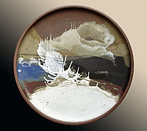
Studio S
P O T T E R Y
WELCOME!
Scroll Down For Additional Information

Ornate Architectural Pieces-Another Step on his Ladder
By Jamie Due Linder, Features Editor
The Accent
The Sunday News Journal
Sunday, December 2, 1984
Everyone has admired a picturesque building adorned with ornate handrails and statues made of marble or granite and wondered at the skill and time that went into producing such works of art. But take another look.
Those beautiful buildings, so painstakingly created, may not be what they appear.
Many of those graceful buildings are now being refurbished with terra-cotta.
What is terra-cotta? Isn't that the stuff that flower pots are made of?
Lewis Snyder, who is one of the few potters in the world who works with terra-cotta, explained it like this:
Terra-cotta is a glazed or unglazed fired clay used especially for statuettes and vases and architectural purposes.
It is -- in other words -- relief ornamentation. Snyder, who is on of the prominent potters in the United States, has escalated from his trademark "people pots" to bigger and better things -- buildings.
"We work closely with building designers replacing what is there or making something new for it," Snyder explained in his huge Studio S. He has set aside a separate room in his studio for his terra-cotta work.
Snyder's work can be seen on several buildings in the United State. Work on the Memphis Cotton Exchange building has just been completed by Snyder and his assistant Gary Sage.
When one walks into the entrance of this ornate building the first thing to catch their eye will be the decorative doorway done by Snyder.
The Hermitage Hotel in Nashville is another example of Snyder's architectural work.
In this instance Snyder took some decorative pieces from the building and made replicas which were placed on the building.
"Every once in a while I go by there and try to pick them out (his pieces)," Snyder said. "But I can't even recognize them -- they blend in so well."
And even in a couple of thousand years, Snyder's pieces will still be around.
"At least that long," he said. "The oldest artifacts of history that we have are hard clay pieces."
Turning some pieces that will soon be ready for firing, Snyder explains, "If one side dries faster than the other it will warp. There is 6 percent shrinkage in the wet stage to bone dry and another 5 percent during the firing process."
After the terra-cotta material is fired, a "textured marblish glaze goes on them,"Snyder said. "It looks more like marble than anything else."
Creating the perfect glaze has always been Snyder's specialty. "We do our own glazes and we make glaze bodies," Snyder asserted. "We spend much time with our colors -- we are known for our different glazing techniques."
But something that Snyder is not famous for is beginning to pop up in his work.
He is becoming distracted from the "more pure in form -- classical" characteristics of pottery which he used to cling to.
"We used to be critical of it in the past," said Sage, who Snyder says is his sidekick and chief assistant. "We are finding out that we can be fun, too. But they don't stray too far from the "pure in form" art.
"There may be a flower or two on something which is unusual for us," Snyder smiled. "The classical form is always there, so it works."
And the Snyder form is usually square.
"Square pieces are my form but now I'm even beginning to work with different shapes," Snyder said, surveying his gallery and pointing to several different shaped pieces.
You might say Snyder is putting a crisp new look on his pieces.
"I used to accent everything in black. Here lately we're using white more," the expert potter said. "I like a piece to look fresh."

Lewis & Eric Snyder